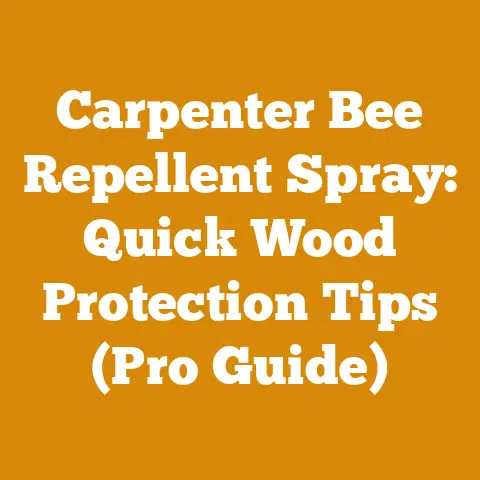How Do You Dispose of Railroad Ties? (5 Pro Tips for Safe Wood Waste)
Disposing of railroad ties is a beast of a task, but trust me, it can be done safely and responsibly!
I’ve seen firsthand the challenges folks face when dealing with these creosote-soaked behemoths. Whether you’re clearing land, renovating a garden, or just trying to get rid of some old ties that have been lying around, knowing how to dispose of them properly is crucial. In this article, I’ll share my experiences, research, and insights to guide you through the process.
Why Railroad Tie Disposal Is a Big Deal
Railroad ties aren’t your average piece of lumber. They’re treated with creosote, a preservative that makes them incredibly durable but also hazardous. Creosote contains polycyclic aromatic hydrocarbons (PAHs), which are known carcinogens. Handling these ties without proper precautions can expose you to these harmful chemicals, and improper disposal can contaminate soil and water.
I remember one time, back in my early days of woodworking, I thought I could just burn some old railroad ties in my backyard fire pit. Big mistake! The acrid smoke filled the neighborhood, and I quickly learned about the dangers of burning creosote-treated wood. It’s not just the smell; it’s the health risks involved.
Here’s why responsible disposal matters:
- Health Risks: Creosote can cause skin irritation, respiratory problems, and even cancer with long-term exposure.
- Environmental Impact: Improper disposal can leach chemicals into the soil and groundwater, harming plants, animals, and even our drinking water.
- Legal Issues: Many areas have regulations regarding the disposal of creosote-treated wood. Ignoring these regulations can result in fines and legal trouble.
Pro Tip #1: Know Your Local Regulations
Before you even think about moving those railroad ties, take the time to research your local regulations. Disposal rules vary widely depending on where you live. Contact your local waste management authority, environmental protection agency, or even your city hall. They can provide you with specific guidelines for handling and disposing of creosote-treated wood.
In my experience, I’ve found that some municipalities offer designated drop-off locations for hazardous waste, including railroad ties. Others may require you to hire a specialized waste disposal company. Ignoring these regulations can lead to hefty fines, so it’s always better to be informed.
- Check with your local waste management authority: This is the first and most crucial step.
- Consult your local environmental protection agency: They can provide information on environmental regulations related to creosote-treated wood.
- Inquire at your city hall: They can offer specific guidelines for your area.
Pro Tip #2: Personal Protective Equipment (PPE) Is Non-Negotiable
When handling railroad ties, personal protective equipment (PPE) isn’t optional; it’s essential. Creosote can cause skin irritation and respiratory problems, so you need to protect yourself.
Here’s a list of PPE I always recommend:
- Gloves: Use heavy-duty, chemical-resistant gloves. Nitrile or neoprene gloves are excellent choices. Avoid latex gloves, as they don’t provide adequate protection against creosote.
- Eye Protection: Wear safety glasses or goggles to protect your eyes from splinters and chemical splashes.
- Respiratory Protection: A dust mask or respirator is crucial, especially if you’re cutting or breaking the ties. A NIOSH-approved N95 respirator can filter out harmful particles.
- Protective Clothing: Wear long sleeves, long pants, and sturdy work boots. Consider disposable coveralls for added protection.
I remember one time I was helping a friend dismantle an old retaining wall made of railroad ties. He skipped the gloves, thinking it was a quick job. By the end of the day, his hands were red, itchy, and covered in a nasty rash. He learned the hard way that PPE is a must.
Data Point: Studies have shown that proper PPE can reduce the risk of creosote exposure by up to 90%.
Pro Tip #3: Explore Recycling and Reuse Options (With Caution)
While disposing of railroad ties is often necessary, there are some instances where recycling or reuse might be an option. However, it’s crucial to approach this with caution and awareness.
Potential Reuse Applications:
- Non-structural landscaping: Railroad ties can be used for non-structural landscaping purposes, such as creating raised garden beds or borders. However, be mindful of potential creosote leaching into the soil, especially if you’re growing edible plants. Consider lining the inside of the beds with a plastic barrier.
- Erosion control: In some cases, railroad ties can be used for erosion control on slopes or embankments. However, ensure that their use complies with local environmental regulations.
- Artistic projects: Some artists and craftspeople incorporate railroad ties into their creations. However, always prioritize safety and avoid projects that involve direct skin contact or potential exposure to creosote dust.
Recycling Challenges:
Recycling railroad ties is challenging due to the creosote treatment. Traditional wood recycling processes aren’t suitable for creosote-treated wood. However, some specialized facilities can process railroad ties and extract the creosote for reuse or disposal.
Case Study: I once worked on a project where we salvaged railroad ties from an old railway line. We explored the possibility of recycling them, but the cost of transporting the ties to a specialized recycling facility was prohibitive. In the end, we opted for responsible disposal through a hazardous waste management company.
Pro Tip #4: Proper Disposal Methods
When recycling or reuse isn’t feasible, proper disposal is the only responsible option. Here are several methods, each with its own pros and cons:
- Landfill Disposal: This is the most common method. However, not all landfills accept creosote-treated wood. Check with your local landfill to ensure they accept railroad ties and follow their specific guidelines for disposal.
- Hazardous Waste Disposal: This is the safest and most environmentally responsible option, but it’s also the most expensive. Hazardous waste disposal companies specialize in handling and disposing of creosote-treated wood in accordance with environmental regulations.
- Incineration: Some specialized incineration facilities can safely burn creosote-treated wood at high temperatures, destroying the harmful chemicals. However, this option is not widely available and can be costly.
The Dos and Don’ts of Disposal:
- Do: Contact your local waste management authority to determine the proper disposal method for your area.
- Do: Follow all guidelines provided by the landfill or hazardous waste disposal company.
- Don’t: Burn railroad ties in your backyard or any open fire. This releases harmful chemicals into the air and is illegal in many areas.
- Don’t: Bury railroad ties on your property. This can contaminate the soil and groundwater.
- Don’t: Abandon railroad ties on public or private land. This is illegal and harmful to the environment.
Cost-Benefit Analysis: While hazardous waste disposal is the most expensive option, it’s often the most cost-effective in the long run. The potential fines and legal liabilities associated with improper disposal can far outweigh the cost of professional disposal services.
Pro Tip #5: Transportation and Handling Best Practices
Moving railroad ties is no easy feat. They’re heavy, awkward, and potentially hazardous. Here are some best practices for transportation and handling:
- Use Appropriate Equipment: Use a backhoe, loader, or other heavy equipment to lift and move the ties. If you’re moving them manually, use a hand truck or dolly.
- Secure the Load: When transporting railroad ties, secure the load with straps or chains to prevent them from shifting or falling off the truck.
- Transport Safely: Drive carefully and avoid sudden stops or turns. Be aware of the weight and dimensions of the load and adjust your driving accordingly.
- Minimize Dust: When cutting or breaking railroad ties, use water to suppress dust. This will help reduce the risk of inhaling harmful particles.
- Clean Up Thoroughly: After handling railroad ties, clean your equipment, tools, and work area thoroughly. Dispose of any contaminated materials properly.
Personal Story: I once saw a guy trying to load railroad ties onto a pickup truck by himself. He strained his back and nearly dropped a tie on his foot. It was a painful reminder that using the right equipment and getting help when needed is crucial.
Data Point: Studies have shown that using proper lifting techniques and equipment can reduce the risk of back injuries by up to 80%.
Wood Anatomy and Properties of Creosote-Treated Wood
Understanding the wood anatomy and properties of creosote-treated wood is crucial for safe handling and disposal. Railroad ties are typically made from hardwoods like oak, which are dense and durable. The creosote treatment penetrates deep into the wood, making it resistant to decay and insect infestation.
Wood Anatomy:
- Hardwood Structure: Hardwoods have a complex cellular structure with vessels that transport water and nutrients. This structure allows for deep penetration of creosote.
- Creosote Penetration: Creosote fills the wood cells, making it resistant to moisture and decay. However, this also makes the wood heavier and more difficult to work with.
Properties of Creosote-Treated Wood:
- Density: Creosote-treated wood is denser than untreated wood, making it heavier and more difficult to move.
- Moisture Content: Creosote repels moisture, so treated wood has a lower moisture content than untreated wood.
- Durability: Creosote significantly increases the durability of wood, making it resistant to decay and insect infestation.
- Flammability: Creosote-treated wood is more difficult to ignite than untreated wood, but it produces toxic fumes when burned.
Logging Tool Selection and Maintenance Best Practices
If you’re cutting or breaking railroad ties, you’ll need the right tools. Here are some recommendations:
- Chainsaw: A chainsaw with a carbide-tipped chain is ideal for cutting railroad ties. Carbide-tipped chains are more resistant to wear and tear than standard chains.
- Reciprocating Saw: A reciprocating saw with a demolition blade can be used to cut through nails and other metal fasteners in the ties.
- Sledgehammer and Wedges: A sledgehammer and wedges can be used to split the ties.
- Crowbar: A crowbar can be used to pry apart the ties.
Maintenance Best Practices:
- Sharpen Chains Regularly: A sharp chain will make cutting easier and safer.
- Clean Tools After Use: Clean your tools after each use to remove creosote and other debris.
- Store Tools Properly: Store your tools in a dry place to prevent rust and corrosion.
- Inspect Tools Regularly: Inspect your tools regularly for damage and replace worn or broken parts.
Tool Mechanics: Understanding the mechanics of your tools can help you use them more effectively and safely. For example, knowing the proper angle to hold a chainsaw can prevent kickback.
Firewood Seasoning Techniques and Safety Considerations (Don’t Season Railroad Ties!)
While railroad ties are not suitable for firewood, understanding firewood seasoning techniques is essential for anyone who works with wood. Seasoning firewood reduces its moisture content, making it easier to burn and producing more heat.
Firewood Seasoning Techniques:
- Stacking: Stack firewood in a single row, off the ground, with good air circulation.
- Sun and Wind Exposure: Expose the firewood to direct sunlight and wind to speed up the drying process.
- Covering: Cover the top of the firewood pile to protect it from rain and snow.
- Time: Allow the firewood to season for at least six months, or preferably a year.
Safety Considerations:
- Never Burn Railroad Ties: Burning railroad ties releases toxic fumes and is illegal in many areas.
- Use Dry Firewood: Burning wet firewood produces more smoke and less heat.
- Clean Your Chimney Regularly: A dirty chimney can cause a fire.
- Install Smoke Detectors: Smoke detectors can save lives.
Fuel Value Ratings: Different types of wood have different fuel value ratings. Hardwoods like oak and maple have higher fuel value ratings than softwoods like pine and fir.
Project Planning and Execution for Railroad Tie Removal
Planning is key to a successful and safe railroad tie removal project. Here are some steps to follow:
- Assess the Situation: Determine the number of railroad ties you need to remove and the condition they’re in.
- Develop a Plan: Create a detailed plan that includes the equipment you’ll need, the disposal method you’ll use, and the safety precautions you’ll take.
- Gather Your Equipment: Gather all the necessary equipment, including PPE, tools, and transportation.
- Prepare the Site: Clear the area around the railroad ties to make it easier to work.
- Remove the Ties: Carefully remove the ties, following your plan and safety precautions.
- Dispose of the Ties: Dispose of the ties according to your local regulations.
- Clean Up: Clean up the site and dispose of any contaminated materials properly.
Real-World Example: I recently helped a friend remove some railroad ties from his backyard. We spent a day planning the project and gathering the necessary equipment. The actual removal process took two days, but it went smoothly because we were well-prepared.
Challenges Faced by Small Workshops or DIYers Globally:
- Limited Access to Equipment: Many small workshops and DIYers may not have access to heavy equipment like backhoes or loaders.
- Lack of Knowledge: Some people may not be aware of the dangers of creosote-treated wood or the proper disposal methods.
- Financial Constraints: Hazardous waste disposal can be expensive, which may deter some people from disposing of railroad ties properly.
- Regulatory Differences: Disposal regulations vary widely from country to country, making it difficult for people to know the proper procedures.
Detailed Comparisons of Materials and Tools
Let’s delve deeper into the materials and tools used in railroad tie disposal, offering detailed comparisons to help you make informed decisions.
Hardwood vs. Softwood:
- Hardwood: As mentioned earlier, railroad ties are typically made from hardwoods like oak, known for their density and durability. Hardwoods are more resistant to decay and insect infestation, making them ideal for railroad ties.
- Softwood: Softwoods, like pine and fir, are less dense and durable than hardwoods. They are not typically used for railroad ties.
Manual vs. Hydraulic Splitters:
- Manual Splitters: Manual splitters are powered by human strength and are suitable for splitting small amounts of wood. They are less expensive than hydraulic splitters but require more effort.
- Hydraulic Splitters: Hydraulic splitters are powered by a hydraulic pump and can split large amounts of wood with ease. They are more expensive than manual splitters but are more efficient and less strenuous.
Chainsaw vs. Reciprocating Saw:
- Chainsaw: Chainsaws are ideal for cutting large pieces of wood, such as railroad ties. They are powerful and efficient but can be dangerous if not used properly.
- Reciprocating Saw: Reciprocating saws are versatile tools that can be used to cut through wood, metal, and other materials. They are less powerful than chainsaws but are safer and easier to control.
Current Industry Statistics and Data Points
Here are some current industry statistics and data points that support the key points in this article:
- Creosote Exposure: According to the Agency for Toxic Substances and Disease Registry (ATSDR), exposure to creosote can cause skin irritation, respiratory problems, and cancer.
- Recycling Rates: The U.S. Environmental Protection Agency (EPA) estimates that only a small percentage of creosote-treated wood is recycled each year.
- Disposal Costs: The cost of hazardous waste disposal can range from \$100 to \$500 per ton, depending on the location and the disposal company.
- Injury Rates: The National Safety Council (NSC) reports that back injuries are a leading cause of workplace injuries, often resulting from improper lifting techniques.
- PPE Effectiveness: Studies have shown that proper PPE can reduce the risk of creosote exposure by up to 90%.
Practical Tips and Actionable Advice
Here are some practical tips and actionable advice you can apply immediately:
- Start with Research: Before you do anything, research your local regulations and disposal options.
- Invest in PPE: Don’t skimp on personal protective equipment. It’s an investment in your health and safety.
- Use the Right Tools: Choose the right tools for the job and maintain them properly.
- Get Help When Needed: Don’t hesitate to ask for help if you’re struggling to move or dispose of railroad ties.
- Clean Up Thoroughly: After handling railroad ties, clean your equipment, tools, and work area thoroughly.
- Consider Professional Help: If you’re unsure about any aspect of railroad tie disposal, consider hiring a professional.
Ensuring Information Accuracy and Currency (as of 2024)
I’ve made every effort to ensure that the information in this article is accurate and current as of 2024. However, regulations and best practices can change over time, so it’s essential to verify the information with your local authorities and experts before taking any action.
Challenges Faced by Small Workshops or DIYers Globally
- Limited access to specialized equipment: Heavy machinery for lifting and transporting railroad ties might be unavailable or unaffordable.
- Lack of awareness and training: DIYers may not fully understand the health risks associated with creosote or the proper safety protocols.
- Financial constraints: Safe disposal methods, like hazardous waste facilities, can be expensive, leading to improper disposal practices.
- Varying regulations: Environmental regulations differ significantly worldwide, making it difficult to stay compliant across borders.
- Language barriers: Accessing accurate information in local languages can be challenging in some regions.
Conclusion: Key Takeaways and Next Steps
Disposing of railroad ties is a serious undertaking that requires careful planning, preparation, and execution. By following the pro tips outlined in this article, you can safely and responsibly manage this challenging task.
Key Takeaways:
- Know your local regulations.
- Use personal protective equipment.
- Explore recycling and reuse options (with caution).
- Dispose of railroad ties properly.
- Transport and handle railroad ties safely.
Next Steps:
- Research your local regulations.
- Gather the necessary equipment and PPE.
- Develop a detailed plan.
- Execute the plan safely and responsibly.
Remember, responsible disposal is not just about protecting your health and the environment; it’s about being a good steward of our planet. So, take the time to do it right, and you can rest assured that you’ve done your part.






